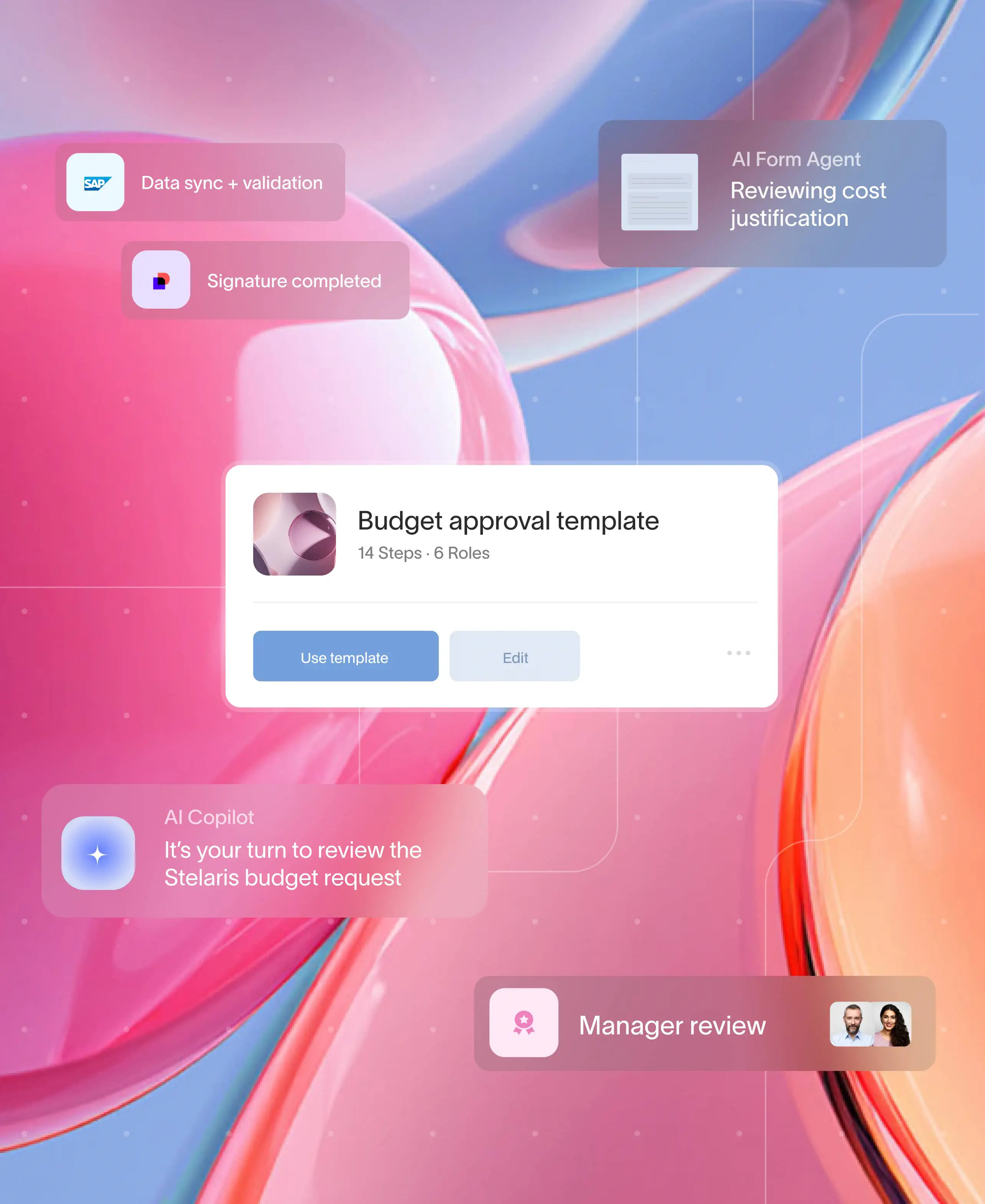.webp)
At a glance
Client portals eliminate email chaos and create professional experiences for your clients
Moxo leads with AI-powered workflows that handle everything from onboarding through ongoing collaboration
Most platforms excel in one area but lack end-to-end process orchestration
The right choice depends on whether you need basic file sharing or intelligent workflow automation
The email problem nobody talks about
Your inbox has 147 unread emails. Twelve are from the same client asking for updates. Sound familiar?
Client portals fix this by enhancing client collaboration . They give every client one place to find documents, track progress, and get answers. No more email archaeology. No more "Did you get my file?" messages.
But here's what vendors won't tell you: most client portal tools just move the chaos from email to another inbox. The good ones actually orchestrate your entire client relationship. Here's what actually works in 2025.
Who needs a client portal
This guide helps teams drowning in client communication chaos:
Consultants juggling multiple projects across email threads
Financial advisors managing sensitive documents in scattered systems
Agencies coordinating feedback loops that span weeks
Legal teams tracking approvals across departments
Investment firms handling complex onboarding and ongoing reporting
Anyone whose clients ask "What's the status?" too often
The 7 best client portal platforms reviewed
1. Moxo: best for process-driven client experiences
Moxo delivers customizable client portals with robust portal features that adapt to each stakeholder's role and responsibilities. It's fundamentally a process-oriented platform that turns complex workflows into smooth client experiences.
What sets it apart: Every person sees exactly what they need, when they need it. A CFO approving budgets sees different workflows than a project manager uploading deliverables. This role-based approach means clients never feel lost or overwhelmed. BNP Paribas cut onboarding time by 50% by giving each stakeholder a personalized journey through their workflows.
Key features include the ability to manage project timelines :
- Personalized portals based on user roles and permissions
- Visual workflow builder for multi-step processes
- Automated approval chains that adapt to each client
- White-labeled experiences matching your brand
- Complete audit trails for compliance
- Real-time collaboration and communication tools
- Mobile apps for stakeholder access anywhere
- AI-powered assistance through Moxo Orchestrator
Best for: Any business managing complex client relationships with multiple stakeholders. From financial services coordinating between advisors and clients to consulting firms managing projects across departments. Keebeck Wealth Management chose Moxo specifically for its ability to create elegant, personalized experiences for high-net-worth clients.
Pricing: Custom pricing based on workflows and users
2. Zendesk: best for support ticketing
Zendesk transforms customer support into organized conversations. It's excellent at what it does, though it's built for tickets, not workflows.
What it does well: Unified ticketing system that brings order to support chaos. If your client interactions are primarily support requests, this makes sense.
Key features:
- Unified ticket management
- Knowledge base creation
- Multi-channel support (email, chat, phone)
- Basic file sharing
- Response automation
Limitations: No workflow orchestration, limited document collaboration, and minimal process automation beyond canned responses. You'll need additional tools for onboarding, approvals, or any multi-step processes.
Best for: SaaS companies and e-commerce businesses where support tickets dominate client interaction.
Pricing: Starts at $55/agent/month
3. SuiteDash: best budget all-in-one for freelancers
SuiteDash bundles everything: CRM, invoicing, project management, and portals. Jack of all trades, master of none.
What it offers: One platform replacing multiple tools. Attractive for solopreneurs wanting simplicity over sophistication.
Key features:
- Built-in CRM and invoicing
- Basic project management
- Simple automation
- File storage and sharing
- Client communication hub
Reality check: The all-in-one approach means each feature is basic. No AI assistance, limited workflow capabilities, and automation that stops at simple triggers. Growing businesses quickly hit its ceiling.
Best for: Freelancers and very small agencies with simple needs.
Pricing: Starts at $19/month
4. Copilot: best for flexible client work management
Copilot helps solopreneurs and consultants manage client work with customizable workflows and templates.
Where it fits: Built for professional services that need structure without rigidity. Good for managing recurring client tasks and deliverables.
Key features:
- Customizable workflow templates
- Client task assignments
- Document collection tools
- Email automation
- Progress tracking and reporting
Limitations: Basic automation capabilities and limited multi-party collaboration features. As teams grow beyond a few people, the platform's simplicity becomes a constraint.
Best for: Startups, solo consultants, and solopreneurs who need flexibility in managing client work.
Pricing: Starts at $29/client/month
5. Dock: best for simple sales handoffs
Dock creates shared workspaces for deals and basic onboarding. Think of it as a prettier Google Drive with task lists.
What it does: Provides a clean space for sharing sales materials and tracking simple onboarding steps.
Key features:
- Deal rooms for sales
- Basic onboarding workspaces
- Content sharing
- Simple analytics
- Integration with common sales tools
Missing pieces: The workflow capabilities are limited to simple task lists and lack automated reminders . No real-time process intelligence, no automated approvals, and no support for complex multi-party workflows. It's a starting point, not a solution.
Best for: B2B sales teams needing basic deal rooms.
Pricing: Starts at $49/user/month
6. OnRamp: best for basic client onboarding
If your portal needs are limited to bringing clients through the door, OnRamp delivers. It's a purpose-built platform for onboarding with clear visual workflows and basic project tracking.
Notable features:
- Branded client web portal with task lists
- Visual workflow mapping with horizontal layout options
- CRM integrations like Salesforce and HubSpot
Trade-offs: OnRamp ends at onboarding. There's no mobile app, limited support for post-onboarding collaboration, and restricted flexibility in complex scenarios. Investment firms using OnRamp often need additional tools for ongoing client management, document sharing, and compliance tracking that platforms like Moxo handle natively.
Best for: Teams focused solely on client onboarding with simple, linear processes.
Pricing: Custom pricing
7. Clientary: best free option for basic needs
Clientary offers bare-bones client portal software features at minimal cost. You get what you pay for.
What's included: Basic client area with file sharing and simple project tracking. Nothing more, nothing less.
Key features:
- Client login area
- File sharing
- Basic project tracking
- Time tracking
- Invoice generation
Reality: No automation, no workflows, no AI, no mobile apps. It's a step above email, but just barely.
Best for: Freelancers testing the portal waters.
Pricing: Starts at $10/month
How to choose: beyond feature lists
Start with your client experience vision
What should each stakeholder see when they log in? How should their journey flow?
Basic portals show everyone the same interface. Maybe some folder permissions. That's it.
Process-oriented client portals like Moxo create unique experiences for each role. The CEO reviewing contracts sees a dashboard of pending approvals. The project manager sees active workflows and deadlines. The end client sees their personalized journey with clear next steps.
Falconi Consulting switched to Moxo specifically for this capability. Their multi-stakeholder approval process became seamless when each person could focus on their specific tasks without the noise.
Consider your actual workflow
Map your real process. Not the idealized version. The messy reality with all its exceptions and edge cases.
If it's linear and simple, basic tools work. If it involves multiple parties, approvals, documents, and decisions, you need orchestration.
Moxo's visual workflow builder handles complexity that makes other platforms break. Bank of Queensland's loan approval process has 27 steps across 6 departments. Moxo handles it seamlessly.
Think beyond today
Your business will grow. Processes will get complex. Client expectations will increase.
1852 Media started with 10 clients. Basic portals worked fine. At 100 clients, they were drowning. After switching to Moxo, they now handle 30% more clients per manager.
Choose a platform that grows with you, not one you'll outgrow.
Evaluate total cost
Cheap tools become expensive when you need five of them. Or when inefficiency costs you clients.
Peninsula Visa cut client drop-offs by 70% with Moxo's automated workflows. That ROI dwarfs any subscription cost.
Implementation reality check
Start with your worst pain point
Pick the process that causes the most friction. For most businesses, it's onboarding. For others, it's approvals or document collection. Moxo customers typically see their first workflow live within 2-4 weeks. Other platforms might go live faster, but with far less capability.
Plan for actual adoption
The best platform fails if nobody uses it. Moxo's interface works like consumer apps. Clients need zero training. Your team gets AI assistance for everything. Compare that to platforms requiring lengthy onboarding or constant hand-holding.
Measure what matters
Time saved. Emails eliminated. Deals closed faster. Clients retained longer. Moxo customers report 60% reduction in manual follow-ups on average. That's time back in your day.
FAQs
What about integration with existing tools?
Moxo integrates with everything: Salesforce, Microsoft, Google Workspace, QuickBooks, and hundreds more through APIs and webhooks. Most other platforms offer basic integrations at best.
How secure are these platforms?
Look for SOC 2 certification, encryption, and audit trails. Moxo provides bank-grade security with complete audit logs. It's why Citibank trusts it for KYC workflows.
Can I customize the experience?
Moxo offers complete white-labeling and workflow customization. Others provide basic branding or rigid templates.
What if we need help?
Moxo provides dedicated customer success teams. Not just support tickets, but actual partners in your success.
How does AI actually help?
In Moxo, AI enhances the portal experience without replacing human relationships. Moxo Orchestrator acts as an intelligent assistant that reviews documents, identifies missing information, sends timely reminders, and answers routine questions. It keeps processes moving while your team focuses on high-value client interactions.





